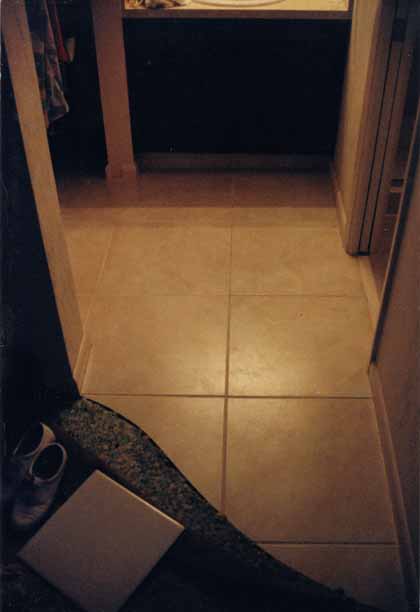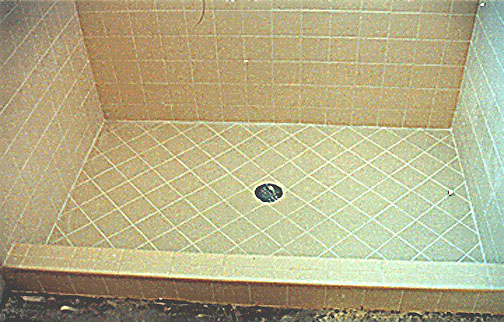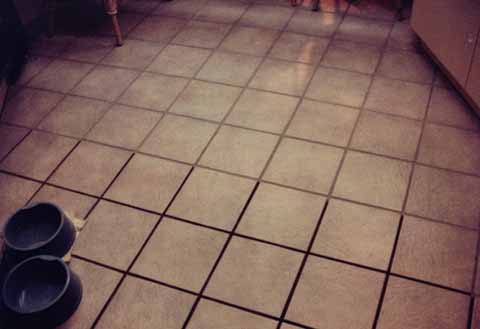 |
||
| | Home | Tips1... | Tips2... | Tips 3... | Natural Stone... | Definitions... | Links... | |
|
Reliable Tile
|
|
|
Tips1...
|
|
|
...one thing I hear alot is: "I need a small tile because my room is small"; well, I'll let you decide: this is quite a small bathroom in the picture below with 20" x 20" tiles; what do you think?
|
|||
|
...no, 'backerboard' is not needed if you are tiling over a concrete
subfloor...
...if you decide to have your grout sealed; use the best sealer you can, use more than one coat, wait the correct amount of drying time before applying, and be concerned with how you will maintain the floor; ie.: any type of 'acidic' cleaner will remove the sealer that you just applied. Don't clean a sealed floor with vinegar and water. Use a cleaner that is compatable with your sealer or a 'neutral', non-acidic floor cleaner... ...in a tub/shower; cut out the 'sheetrock/greenboard', use roofing felt as a waterproofing membrane, and a 1/2" backerboard to tile to; the backerboard will be even with the sheetrock and that way you will have a nice edge and the backerboard will last way longer than that paper stuff; there are many different types of backerboard available for you to choose from: Dens-Shield, WonderBoard, Durock, Hardibacker, just to name a few... ...the hot item on walls now is to leave your sheetrock in the tub/shower area and go over them with Schluter
Kerdi. Do a little research on this...
...if you are considering going into the business; buy the best tools you can - Rubi, Felker, Target, Gundlach, Marshalltown, amongst others; they will work better and last longer; Target and Felker are two brands of tile saws that have a smoother rolling tray than MK, in my opinion; Home Depot is not the place to be buying tools unless for limited use or you are on a budget; and Rubi manual tile cutters last, are quick and accurate... ...if doing a shower floor, be sure to mud a pitch before the pan liner/waterproofing and afterwards also; if anything is flat/level down there, the water will not drain properly; the only reason I mention this is because I have seen it done wrong so many times... ...after installing your shower pan liner; be sure to leak test it...
...a good book to get is 'Setting Tile' by Michael Byrne; it's about twenty dollars at most book stores or home improvement centers; you could also check it out at your local library... ...another fine book is 'Tile Your World' by John Bridge; there is a link to his website on the links page; excellent
website also that is chock full of good info...
...be careful of what you hear at 'home improvement centers'; alot of incorrect information is given out at these places; find out the background of the person giving you the information - is he/she qualified? How much tiling experience do they have?... ...it's a good idea to purchase enough tile so that you will have an extra box that you can store; if you ever have a need in the future, you will have a matching tile to do any type of repair/mod with... ...one of the most important items in the durability of your tile installation is the quality of the install; when tile is installed properly, you will have a very slim chance of it breaking on you under normal conditions... ...the two main types of grout for you to choose from are either sanded or unsanded; the main deciding factor for you is: "what is the size of my grout joint?" Less than 1/8", go for unsanded. 1/8" and over, go for sanded. It's that simple... ...there is another type of grout that may be of interest to you - epoxy grout. Yes, it costs more and is more work to put in; but, you don't have to worry as much about your grout becoming discolored... ...if using epoxy grout on a vertical surface, ie.: bathroom walls or backsplashes, make sure to use one that is designed to be used on vertical surfaces that has a non-sag additive incorporated into the contents... ...epoxy grout does not need to be sealed. You still have to care for your tile surfaces tho'. A new more user friendly
epoxy grout on the market is Laticrete SpectraLock. It's available at Lowe's in mini-units which are quite small. You can
purchase it at a distributor in larger units; but they won't have the volume buying power as a big box store so there won't
be much cost savings, if any. The SpectraLock has some interesting additives. One is a glow-in-the-dark while another adds
a metallic to it which I believe is called Dazzle.
...can't find an inside or outside corner trim piece; miter what you have to fit and it'll work fine... ...using a tile with no matching bullnose pieces available for wrapping an edge; use a 'schluter system' trim piece or just miter the backsides of two pieces of tile and then they will fit closely together and will look just fine with a small grout joint...i'll draw up a sketch of this one eventually... ...actually had an 'installer' tell me that you couldn't use a 4" x 4" tile in a shower floor because it was too large to follow the pitch. Get real!!! ...more to come... this is one of those shower floors that I once had an 'installer' tell me couldn't be done!?
...you can renew your old, dirty grout with a grout stain; as shown below:
|
|||
|
QFJGSS7P |
|||


